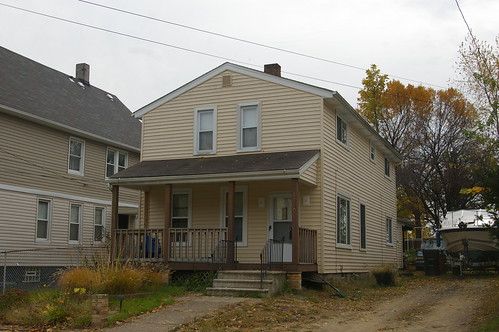
Usually, it's easy to identify historic houses. Even when they've been seriously remodeled, they contain some details that offer clues to the history of the structure. There are some, however, where most of the obvious historic detail has been obliterated. Further, there are some houses that simply didn't have much detail to begin with.
Take this historic house, at 6710 Lawnview Avenue, in the Hough neighborhood of Cleveland, Ohio as an example. It was probably built in the 1840s or 1850s. It's not on one of the older streets in the area. It's not shown on maps from the 1850s and 1870s. The exterior has been covered with vinyl siding. The windows have all been replaced, mostly with ones of a different shape from the originals. The foundation appears to have been covered with mortar, so we can't see any significant details of its construction. I drove by it a couple times without even noticing it.
One small clue as to the age is the siting of the house on the lot. This house is physically farther back from the street than the other houses on the block. While this isn't always an indicator, it's something worth paying attention to, especially when all of the other houses on the street are the same distance from the road and your subject is the only outlier. It's also worth paying attention to houses that aren't sited parallel with the road. This can suggest that the house was built before the road was put through, or before it was aligned in the way it is today.
A bigger clue are the proportions of the house. The pitch of the roof is consistent with what we would expect to see in a Greek Revival house. Look at the two windows on the front of the house, on the second floor. While they are replacements, the narrow openings are consistent with a house of the style, built in the 1840s or 1850s. Windows from a house built later would have been larger.
Finally, look at the foundation. This doesn't help on this house and can often be misleading, because houses can be moved and put on new foundations, but it can be a valuable clue. Take this house, for instance. The hand-hewn sandstone foundation shows tool marks that you won't find on a house built in the 1860s or 1870s.
How do you learn to see these details? It helps if you look at a lot of old houses, so that you can see how the details on some of them are hidden and changed. The Cleveland Restoration Society offers and excellent guide, Architectural Styles Found in Northeastern Ohio, which is quite helpful. For a more in-depth look, see Carole Rifkind's Field Guide to American Architecture.
Of course, there are still some houses that, no matter how much I stare at them, I can't figure out when they were built. Styles change over time and sometimes people design things in a way that fell out of style a decade or two previous. In another post I'll share the details of a pair that have me stumped, at the corner of Lakeview Road and Auburndale Avenue.




I would've pegged this house as 1915-1925...as a typical colonial revival.
ReplyDeleteThat's what I thought, too, when I first drove by it.
ReplyDeleteOne detail that caught my eye and made me really think about this house is the chimney - it shows considerably more wear and age than one would expect for a house built c. 1915-25.
This house isn't that architecturally interesting, but given how few houses of this vintage are still standing in Cleveland outside Ohio City, I think it's worth knowing where all of them are.
The "Architectural Styles Found in Northeastern Ohio" link no longer works and I can't seem to find the pdf on their site. Do you have a copy of the pdf that you'd be willing to email me? Thanks
ReplyDelete